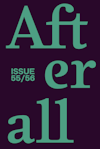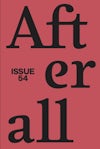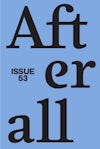
Issue 11
Spring/Summer 2005
Editors: Charles Esche, Thomas Lawson, Mark Lewis, Silke Otto-Knapp, Zoe Crosher.
Founding editors: Charles Esche, Mark Lewis.
Table of contents
Foreword
Contextual Essays
- From Specific Objects to Specific Subjects: Is there (still) Interest in Pluralism? – Mary Leclère
- People on a Sunday, Octopus on a Tuesday
- Paranoia Americana: The New Work of Cady Noland – Steven Parrino
Artists
The Wooster Group
- Devotion and Betrayal: Air Time/Hang Time in The Passion of Wooster – Jane Philbrick
- Not a Condition but a Process – Thomas Lawson
Rachel Harrison
- The Stuff: Rachel Harrison’s Sculpture – Catherine Wood
- Two into One – Brian Sholis
Harun Farocki
- Harun Farocki: Film-maker, Artist, Media Theorist – Thomas Elsaesser
- Production Pattern Associations: On the Work of Harun Farocki – Jan Verwoert
Manfred Pernice
- The Stage of Accumulation and Reproduction on an Expanded Scale – Will Bradley
- The Picket Fence – Eva Meyer-Herrman
David Lamelas
- More to the Picture – Chus Martinez
- David Lamelas: The Limits of Documentary – Stuart Comer
Foreword
Written by Charles Esche
Another issue of Afterall, and another opportunity to consider what role art does or could play in the world. This issue continues with some basic reasons (perhaps beliefs) that underpin each issue of our journal…
Another issue of Afterall, and another opportunity to consider what role art does or could play in the world. This issue continues with some basic reasons (perhaps beliefs) that underpin each issue of our journal. We consider that art’s significance lies in the influence it exercises on how our societies choose to think and behave. Yet such influence can only be traced and expressed indirectly, and most effectively through the study of singular experiences with works of art. Art also has certain responsibilities to its audiences and contexts yet that act of making art should be free of direct political requirements. For these reasons, we have always sought to privilege the individual artist in our journal, allowing the work to speak about the issues that it reveals rather than insert the work into an existing discourse. This becomes crucial if we are to see the art field as being an autonomous zone where propositions can arise independent of social or economic function.
The value of art’s autonomy was only fully established under the terms of western European and then American modernisms, as a way to defend categorically the ‘free’ space of personal expression that art could then occupy. Its legacy into our period has been mixed, permitting art to be justified solely in terms of its own criteria (and thereby able, constantly, to remake itself) while isolating it from specific historical contexts in which it sought to play a role. Art in social democratic capitalism was tolerated so long as it largely concerned itself with its own condition – a situation that continued into the 1980s to be finally countered by the full expansion of the free market into the consumption of creativity. Cynically, we could now say that art’s autonomy is no longer based on the idea of ‘free space’ but on its clear economic value in the market, except that this is no autonomy at all.
Purchase
The publication is available for purchase. If you would like specific articles only, it is also available individually and to be downloaded as PDFs.
Purchase full publication
Buy via University of Chicago Press
Buy via Central Books
Purchase individual articles
Buy via University of Chicago Press



